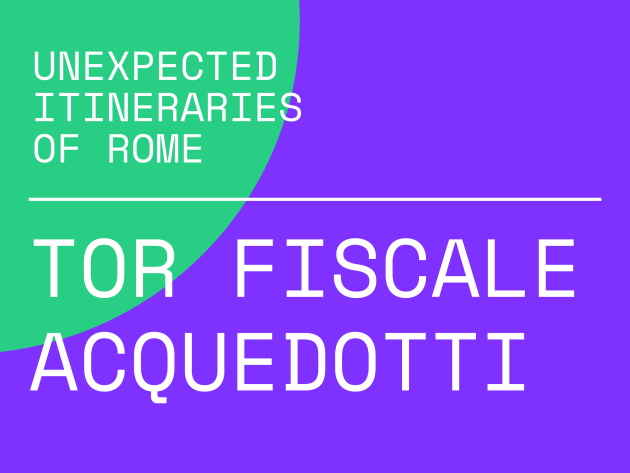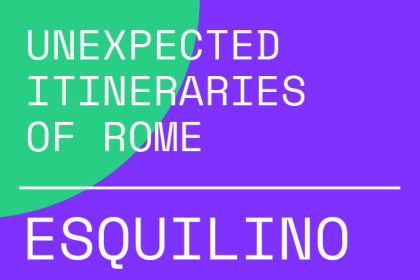
The itinerary, which can be covered on foot or by bicycle, is about 4 kilometres long and is easily accessible by public transport (Line A of the Rome Metro).
The route starts from the Casale Museo at the entrance of Via dell'Acquedotto Felice - but you can also enter from from Via Lemonia and the Viale Appio Claudio - winds its way through the Parco di Tor Fiscale and the Parco degli Acquedotti and ends in the area of the archaeological site of the Villa delle Vignacce, near Via Lemonia. It can also be walked in the opposite direction.
Numerous historical and archaeological testimonies of Rome's millenary history are scattered along the route in a protected green area, for which we recommend comfortable shoes and a water bottle.
Description of the itinerary
True oases of unspoilt greenery inside Rome, the Parco di Tor Fiscale and the adjacent Parco degli Acquedotti are part of the Parco dell'Appia Antica. Both are a perfect combination of history and nature, the ideal destination for a regenerating walk to discover archaeological treasures immersed in the biodiversity that has found fertile ground here.
The two parks house priceless historical testimonies: the Torre del Fiscale and the well-preserved remains of seven Roman aqueducts, including the imposing Claudian and the elegant Felix.
Strolling among these millenary remains, you can take a journey back in time, admiring the grandeur of Roman water engineering and the importance these works played in the daily life of the time.
The paths winding along the itinerary involve all the senses: the scents of the Mediterranean maquis, the sounds of nature mingle with the chirping of birds and the flow of water, while the view fades into wide green valleys, creating an atmosphere of peace and tranquillity.
Historical and archaeological points of interest
Casale Museo Tor Fiscale - Information Point
At the entrance to the Parco di Tor Fiscale, the Casale Museo welcomes you. Here you will find the Information Point where you can receive information on how to explore the paths through the greenery. An experience not to be missed for lovers of history and nature.
Fountain of Benedict XIV
An 18th century architectural jewel, set in the Acquedotto Felice within the Parco di Tor Fiscale. Commissioned by Giovanni Costanzo Caracciolo in 1745, at the time of Pope Benedict XIV, it has a vertical wall, which previously contained a commemorative epigraph and at the top a tondo decorated with a fresco depicting the Madonna, unfortunately almost disappeared. A work that combines history, art and nature, a symbol of the bond between man and water. A place to visit to admire its beauty and learn about its historical value.
Claudian Aqueduct
The Claudian aqueduct (in Latin Aqua Claudia), the eighth in order of construction, was one of the most important in ancient Rome, both for the cutting-edge technology used and the considerable labour involved, as well as for the magnitude of the expenses incurred to build it. Construction of the aqueduct was begun in 38 A.D. by Emperor Caligula and was completed under the principate of Claudius in 52 A.D. It was 46,406 Roman miles long, or 68.681 kilometres. It drew water from small lakes formed by two springs, called Caeruleus and Curtius, located in the upper Aniene valley between the present-day towns of Arsoli and Marano Equo.
Felix Aqueduct
Between 1585 and 1587, more than thirteen and a half centuries after the construction of the last aqueduct, Matteo Bortolani and Giovanni Fontana built the Felix Aqueduct, commissioned by Pope Sixtus V (born Felice Peretti, from whom the aqueduct takes its name). The springs of the Aqua Alexandrina and others from the surrounding area were used for its construction. Its course ends with the monumental Fountain of Moses by Domenico Fontana. The aqueduct was intended to supply water to the areas of the Viminale and Quirinale hills, but it is likely that the primary intention was to supply water to the papal villa on both hills. Its construction caused the destruction of the older aqueducts Marcius, Tepula and Iulia in some sections.
Torre del Fiscale
Over 30 metres high, the Torre del Fiscale stands at the junction of the Claudian and Marcius aqueducts, and is crossed by the Tepula and Iulia water conduits. It was built in the late 12th or early 13th century using an archway of the Roman aqueduct as a base. Illuminated to great effect at night following restoration completed in 2018, it offers a glimpse into Rome's agricultural past and efforts to preserve historical evidence.
View of the Claudian and Felix Aqueducts
The overall view of the park, with the Claudian and Felix Aqueducts, allows you to enjoy the area they cover: the Parco di Tor Fiscale and the Parco degli Acquedotti, part of the Parco dell'Appia Antica, which, at 4,580 hectares, is the largest urban protected area in Europe. A green wedge that runs from the city centre towards the Castelli Romani, where history, archaeology and nature come together in a landscape and environmental framework of exceptional interest.
Casale Roma Vecchia (Roma Vecchia Farmhouse)
The building located between the fourth and fifth mile of the ancient via Latina was originally a tower-house, strategically placed between the Claudian and Marcius aqueducts with the function of controlling and defending the territory.
The core, made of lava stones, peperino blocks and fragments of ancient marble, mixes Roman and 13th-century elements. Various archaeological finds from the area can still be found on the walls of the inner courtyard.
The name ‘Roma Vecchia’ derives from the numerous and extensive Roman remains in the vicinity, once considered a city due to the significance of the finds and the imposing ruins of the Villa dei Sette Bassi.
Fosso dell'acqua Mariana (Mariana Water Ditch)
Near the Casale Roma vecchia runs the Acqua Mariana canal, originally parallel to the aqueducts, which feeds an artificial lake. Built in 1122 by Pope Callistus II, it boosted the water supply of Rome and the Lateran, diverting from the Squarciarelli springs through the Parco degli Acquedotti and the Parco diTor Fiscale, to reach the Porta Asinaria and the Tiber river. Once vital for mills and irrigation, it has now largely lost its original articulation.
Claudian Aqueduct - Detail of the section of the conduit
A section of the water conduit of the Claudian Aqueduct and the upper canal of the Anio Novus, which soon overlapped the Claudian one, is visible, showing the interior and functioning of the conduit itself. Started in 38 AD by Caligula and finished in 52 by Claudius, it is over 68 km long and runs largely underground. It emerges near the Capannelle area and inside the Parco degli Acquedotti, where it reaches a maximum elevation of 28 metres above ground. It was one of the most important aqueducts of ancient Rome, a work of engineering that still bears witness to the greatness of the Empire. A plunge into history not to be missed by archaeology and engineering enthusiasts. From this point, looking towards the city, you can enjoy a breathtaking view of the majestic Dome of St. Peter's Basilica.
Villa delle Vignacce
Near Via Lemonia, the northern side of the park reveals the remains of a vast villa from ancient Rome. Excavations have brought to light structures from the 1st century B.C. to Late Antiquity. To the latter phase belongs a particularly interesting thermal area, with a circular hall with a vault lightened by the use of amphorae. In the 2nd century, the villa belonged to the senator Quintus Servilius Pudente, an important owner of brick factories. A statue of Marsyas, the satyr who dared to challenge Apollo, originally from Asia Minor, found in this area, enriches the Museo Centrale Montemartini in Rome.
Fr Roberto Sardelli and Scuola 725
In 1965, Fr Roberto Sardelli was ordained a priest and, after an initial experience in Vitinia, was sent to San Policarpo.
Along the ruins of the Felix Aqueduct, he saw shacks rising, miserable houses without light or water, inhabited by immigrant families from central and southern Italy, who had sought accommodation and work in Rome.
Fr Roberto refused the privileged parish life and chose to go and live in a shack in the Aqueduct. Here he founded a school for the girls and boys of the little neighbourhood: Scuola 725, after the number of the barrack building. The local youngsters attended public schools, but were marginalised and felt inferior because of their social status. Therefore, Fr Roberto wanted School 725 to become the school of redemption.
In the vicinity - Murals
Not far from the Parco di Tor Fiscale is the Quadraro district that stands out for its liveliness and identity, told through its murals, works that combine past and present, historical memory and contemporary artistic languages. Street art in the Quadraro is not only aesthetic, but is a narrative voice, an instrument of social denunciation and a catalyst for reflection. A dialogue between past, present and future unfolds on the walls of the district, making it a unique and vibrant place.
Botanical and natural points of interest
Giardino della Biodiversità ((Garden of Biodiversity)
Founded in 2017, this educational space promotes biodiversity by integrating sensory trails with flowers and aromatic plants that attract butterflies and insects.
In the garden, you can find mint, rosemary, thyme, basil, lavender, lantana, citrus trees and especially the Buddleja-davidii, the Butterfly Tree. The park's volunteers take care of these plants, promoting environmental education for children in nearby schools.
Parco di Tor Fiscale
The park covers 11 hectares in the Appio - Tuscolano district and takes its name from the ancient medieval tower of the Fiscale, dating back to the 12th-13th centuries AD, located along the route of the Claudian (52 AD) and Felix (1585 AD) aqueducts, built by Pope Sixtus V. Inside are numerous tree species, including the Cypress,
the Olive, the Wild Lime, the Domestic Pine, the Japanese Privet, the Sycamore Maple, the Black Hornbeam and the Hybrid Plane Tree.
‘Grove’ in the Parco degli Acquedotti
The tree stock in the Grove in the Parco degli Acquedotti includes the Cypress, Olive, Holm Oak, Japanese Privet, Cedar of Lebanon, Rosary Tree or Paternostrum, Wicker Willow, White Poplar, Black Poplar, White Mulberry, Lodgepole Pine, Oriental Plane, Sycamore Maple, Strawberry Tree and White Willow.
The event is part of the Unexpected Itineraries of Rome project - CUP J89I22001930001 - Financed by the Measure Grandi destinazioni per un turismo sostenibile (Sheet No. 51) of the Ministero del Turismo's Development and Cohesion Plan (PSC), approved by CIPESS resolution No. 58 of 3 November 2021.
Unexpected Itineraries of Rome

Seven unusual itineraries to discover the city from new perspectives
Unexpected Itineraries of Rome - Osa-Gabii and San Vittorino Itineraries

 Condividi
Condividi
Unexpected Itineraries of Rome - Esquilino Itinerary - from Santa Croce in Gerusalemme to the Ex Acquario Romano

 Condividi
Condividi
Informations
 Condividi
Condividi











































